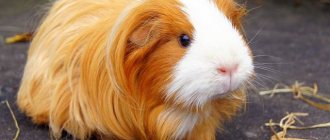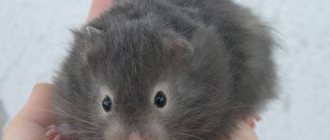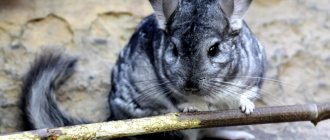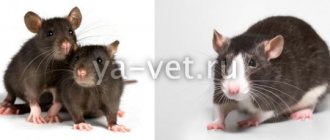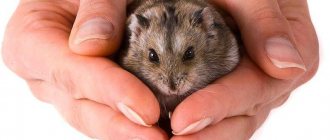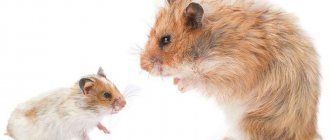It is important to identify dermatological diseases of hamsters at an early stage in order to avoid complications in your pet. After all, skin diseases are often caused by bedding in which many microbes accumulate, or an accessory with fungal microspores.
We will learn how to diagnose lichen, demodicosis and other pathologies, how to treat your pet and how to prevent re-infection.
Signs of the disease
Most often, ringworm is diagnosed in hamsters.
Both an adult and a young hamster can get sick, but, as a rule, young animals get sick more severely and seriously. This is due to imperfect immunity, nutritional deficiencies, and viral infections. Breeders often wonder where a pet animal can get this disease if it does not leave the apartment. It turns out that the virus is transmitted not only from a sick animal, it can be brought into the house by a person from the street on shoes or clothes. If the hamster's immunity is reduced, it is sick, or there is damage to the skin, this can cause rapid infection. Fungal spores are very stable and can remain on the hair throughout life, so the cage, drinking bowl and feeder are also contagious. The fungus, when it gets on the skin, penetrates the tissue, multiplies quickly, and releases toxins. They are the ones that cause itching and inflammation of the skin. The infection destroys the hair structure, causing baldness of the infected area of the skin.
Diagnosing the disease at home is difficult, because hair loss, baldness or itching may not necessarily indicate the appearance of lichen. In this way, allergies to food, parasites, mites manifest themselves, and hair loss can be associated with baldness
Therefore, it is so important to seek advice from a specialist in time and not to independently treat the animal. The veterinarian will scrape the damaged areas of the skin, conduct a laboratory test (examine the hamster with a Wood's lamp, which, if ringworm is present, shows a green glow) and prescribe the appropriate type of treatment
In any case, when lichen appears, the following symptoms occur:
- spots on the skin of different shades;
- rash;
- peeling;
- skin itching;
- hair loss;
- restless or aggressive behavior;
- refusal to eat.
If you notice the presence of any strange scabs on your pet’s body, immediately contact a veterinary clinic, because an infectious disease is dangerous not only for the animal, but also for your family.
Symptoms of the disease
The main symptom of lichen in a hamster is spots on the skin without hair. The hairs usually break off. You can see peeling and redness on the skin. The main signs of this disease are:
- inflammation of the affected area;
- small rash;
- itching in the affected area;
- peeling and crusting;
- hair loss;
- poor appetite and nervousness of the animal.
These rodents are characterized by two types of lichen.
Shearer
It is characterized by bald patches on the face and front of the body. You can see an animal that is affected by this disease in the photo. These spots are quite itchy, and the rodent scratches them on its own, which leads to the fungus spreading to healthy areas.
This disease can appear for the following reasons:
- weakened immune system;
- mechanical injuries to the skin in combination with the presence of a pathogen in the environment. The pathogen can be brought with various objects that have been in contact with the patient. The pathogen is transmitted from person to person and from person to animal.
Pink
The main symptom is the presence of pink areas of skin. They are also very itchy and the animal constantly scratches them. The center of the spot is a lighter, paler color than its edges. Peeling is visible along the borders of the spots.
This type of lichen can go away on its own, and this form of the disease is not contagious to people. It most often appears as a result of decreased immunity during the changing seasons.
Other diseases of hamsters
Ringworm
Hamsters are unpretentious compared to other animals and rarely get sick. The main causes of their diseases are violations of the rules of maintenance and care, as well as an unbalanced diet.
Allergy
An allergic reaction (sneezing) can be caused by a new food or some of its components. In this case, you should discard this food. If the bedding in the cage can be made of a material that the animal cannot tolerate, you need to change the bedding. Sneezing in a pet can also indicate pneumonia (pneumonia), so it is necessary to take the animal to a veterinarian and conduct a full examination.
Causes of hair loss
They can be divided into two categories: natural and pathological shedding.
The pet is healthy, active, eats well, but the fur is very loose.
Seasonal shedding - old wool is replaced by new. Occurs intensely on the abdomen and the inside of the legs, and almost imperceptibly on the back.
Age - on average, hamsters live three years, a two-year-old rodent is already considered old, and it is quite natural that he began to go bald.
Hormonal changes – during pregnancy, females can experience intense hair loss. Also, bald spots on the abdomen appear in hamsters that feed their young.
Sometimes hair loss can indicate health problems or improper care. The causes of baldness should be excluded and checked in order:
Filler - some of them can cause an allergic reaction in a rodent.
Nutrition - it must be balanced with all the necessary elements so as not to cause vitamin deficiency. Sometimes hamsters develop intolerance to some fruit or vegetable, it is worth finding out by elimination.
Stress – constant change of environment can lead to baldness.
Diseases are one of the most dangerous causes. Only a specialist can make a diagnosis and prescribe effective treatment.
Lichen squamosus (psoriasis)
Squamous lichen can be located on the torso, extensor surfaces of the arms and legs, on the scalp, on the palms, and on the face.
The first signs of scaly lichen in humans (see photo):
- A specific rash appears on the skin, which is flaky, rounded bumps of pinkish-red color that rise above the surface;
- If you scrape, the whitish-gray scales crumble, revealing a shiny, wet, red surface underneath. If you scrape it too, pinpoint bleeding occurs;
- The tubercles grow and form plaques up to several centimeters in diameter, then merge into solid areas with uneven edges;
- Most often, they begin to dissolve from the middle, forming a garland on the skin. And in the place where the rash disappeared, an area with disturbed pigmentation forms;
- The disease is accompanied by severe itching.
Today, more than 20 methods have been developed for the treatment of scaly lichen, none of which can guarantee a quick and complete cure. Treatment depends on the phase of the disease and the location of the lesions.
- At the first stage, injections of vitamins, sensitizers or histamines are practiced.
- At the same time, corticosteroids and sedatives are prescribed.
- At the stationary stage, injections of staphylococcal antitoxins, autohemotherapy, and ultraviolet radiation are often recommended.
- Severe forms can be cured with plasmapheresis and cytostatics.
Currently, specialists have learned to use various techniques to alleviate the patient’s condition, keeping the disease in a stationary stage.
Treatment
Certain types of fungus are treated exclusively with antifungal drugs, which should be prescribed by a specialist. Having determined the type of fungus and the degree of infection, the required dosage of the drug and course of treatment are prescribed.
| Triderm | Complex antifungal drug that is applied externally | The course of treatment is 10-14 days. During this period, you need to apply a thin layer of ointment to the affected areas of the skin 2 times a day. |
| Fluconazole | An antifungal drug that suppresses the synthesis of fungal spores, which should be used once a day | Course of treatment 2–4 weeks |
| Griseofulvin | Antibiotic prevents fungal cell division | The course of taking the drug is prescribed by a veterinarian |
| Ketoconazole | A broad-spectrum drug that allows you to stop the synthesis of cell membrane substances, destroying the fungal membrane | Treatment course 10 days |
First of all, it is necessary to completely isolate the sick hamster from other pets. Next, disinfect all objects with which it came into contact; if it is an inexpensive item, then it is better, of course, to throw it away completely.
Before starting treatment, it is necessary to remove the affected hairs in those areas of the body where the disease is observed, since they are infected with fungal spores. The scissors with which you cut the hairs must be boiled for 10 minutes and treated with disinfectant. means to destroy fungal spores.
In addition to medications, you also need to treat the lesions with iodine solution and salicylic ointment. Thanks to the components contained in iodine, the infected surface of the skin is well disinfected, and with the help of ointment, the affected areas can be quickly restored. Also, during the treatment period, it is necessary to give your hamster special medications that support the immune system and restore the microflora.
Every experienced breeder knows well how to treat lichen in hamsters. The first step is to remove hair from the affected areas. Ideally, you can completely remove all fur, because this is the only way to get rid of spores. At this time, the cage, drinking bowl and feeder must be thoroughly washed and disinfected. The animal must be isolated and handled only with gloves. You will have to live in this mode for about a month.
The duration of treatment depends on the condition of your pet and his body. On average it takes two or three months. Most importantly, therapy should continue until complete recovery. Otherwise, there is a high risk that the disease will return. After the scabs disappear, you need to show him to the veterinarian again and get tested. After this, the animal can be considered completely healthy.
Let's get treatment!
The spores of the causative agent of ringworm are very stable: they can remain on the hamster’s fur throughout its life, therefore all objects surrounding the animal are also infectious.
Knowing the seriousness of microsporia, the first step that the owner of a sick animal should take is to go to the veterinary clinic.
Touch a sick hamster only with gloves!
And after examining it, your hands should be washed thoroughly with antibacterial soap.
Consultation and examination by a veterinarian with tests are necessary to establish an accurate diagnosis and choose treatment tactics.
Be sure to disinfect the cage.
First of all, if you have more than one hamster, you need to isolate it from other pets so as not to expose them to infection.
How to treat a hamster suffering from lichen at home? The actual treatment process begins with the complete removal of hair on the affected areas of the skin in order to remove fungal spores nested on the animal’s fur.
The safest way to burn hair that has been cut is to burn it. All dishes and the hamster’s “living space” are thoroughly disinfected with a sulfur-carbolic mixture or formaldehyde solution, or even replaced with new ones.
The etiology of lichen can be different - both viral and fungal. Depending on this, “Doctor Aibolit” will prescribe antiviral or antifungal drugs:
- antibiotic,
- vaccines,
- immunostimulants,
- creams,
- ointments,
- solutions,
- pills,
- shampoos.
Experts recommend treating lichen in Syrian hamsters like scab: scabs and scales on the affected areas, after softening them with neutral oil or fat, are carefully cleaned off and treated every day with a mixture of tincture of iodine in equal parts with alcohol solutions of the following substances:
- glycerol,
- creolin,
- Lysol,
- salicylic (or picric) acid.
Both Syrian and Djungarian hamsters require not only local, but also systemic treatment with internal use of antifungal drugs.
Considerable patience is required, since it may take more than one month before complete recovery. When the external signs of the disease disappear, a follow-up examination and the necessary laboratory tests from a veterinarian are required, which can confirm the success of treatment.
Success or failure to a large extent depends on the stage at which the disease was “caught.” The early stage is completely curable. It is equally important to take the treatment process responsibly: if the treatment is carried out incorrectly, the disease will take on an advanced chronic form, and the hamster will suffer for the rest of its life.
Why does a hamster itch?
Prevention measures: how to prevent infection
To protect yourself and your loved ones from contracting infectious diseases carried by hamsters, you should remember a few basic rules when keeping them:
It is advisable to purchase a furry pet only from breeders or pet stores with a good reputation.
When buying an animal on the market, the owner risks purchasing an animal infected with infection; When choosing a hamster, it is recommended to pay attention to its appearance and behavior. Sick hamsters have dull, sloppy fur, bloodshot eyes, and act lethargic and lethargic; It is necessary to monitor the cleanliness of your pet’s home and remove dirty litter in a timely manner.
This way, the owner will not only get rid of the unpleasant odor from the cage, but will also reduce the risk of infection entering the animal’s body; The rodent should be fed only high-quality food. Stale and rotten grains can cause various diseases in hamsters; When cleaning the cage, the owner should always wear gloves, since infection can be spread not only through contact with the animal, but also through its feces.
You should not give up the pleasure of communicating with a miniature fluffy hamster just because there is a possibility of contracting some disease from it. After all, if you properly care for and care for a small creature and pay enough attention to it, then the funny animal will always delight the owner with activity, health and well-being.
Why is a hamster dangerous?
How to treat at home
Before treatment begins, the sick animal is isolated from other pets, all objects with which it has been in contact are disinfected or disinfected and replaced with new ones. It must be taken into account that you cannot simply throw away a cage or feeder - they are contaminated with a pathogen and will be dangerous to other people and animals.
Important! Triderm is the main complex antifungal drug used for various skin pathologies. Apply externally for 10–14 days
Apply a thin layer to the affected areas after disinfection 2 times a day.
Treatment should be systemic (support of the body) and local (treatment of lesions). The lesions are treated with iodine solution and salicylic ointment. Iodine disinfects the surface, and antibacterial ointments help restore it. The hairs in the affected area are first removed, as they are infected with fungal spores. If there are crusts, they must be softened and removed. The duration of treatment is at least 30 days, until the symptoms of the disease disappear. Internally, agents are prescribed that support the immune system and restore the microflora.
The medications are prescribed by the doctor, depending on the type of fungus that has infected the animal. This takes into account the weight of the hamster and the degree of infection. Do not experiment with treatment. Trust the prescription of the course and determination of dosages only to a specialist.
Hair removal
The hamster needs to be handled on oilcloth or other surface. After processing, equipment (scissors) must be boiled for at least 10 minutes to destroy fungal spores. It is imperative to work with gloves; the surface of the table on which the procedures are carried out is covered with disposable oilcloth, which is then destroyed along with the hairs, since they contain fungal spores. When working with a sick rodent, gloves must be worn. All potentially infectious objects used during the treatment of a hamster must be worn. must be stored out of the reach of children. It is imperative to ensure their complete isolation from direct contact with other objects.
Disinfection of housing and equipment
If you have a quartzizer, it is necessary to treat the room for 20–25 minutes daily. Clothes are washed using white. Soft surfaces (sofas, armchairs, carpets) are sprayed with chlorhexidine vapor.
Floors, walls, doors and other surfaces are treated with an aqueous solution of bleach in a ratio of 10:1 or another disinfectant that has antibacterial properties.
Antiviral and antifungal drugs
Medicines that suppress the activity of fungi are called antimycotics. Their action is aimed at destroying the fungus or preventing the proliferation of spores.
Important! Injections are given to the hamster subcutaneously at the withers with an insulin syringe. Before manipulation, the injection site is treated with alcohol
Intramuscular injections are performed into the muscle of the hind paw.
Antifungal drugs are not universal and act on certain types of fungi, therefore they are prescribed only after the type of fungus has been determined by a doctor:
- Fluconazole - inhibits the synthesis of fungal spores. To treat lichen, a course lasting 2–4 weeks is prescribed. Use once a day in the dosage prescribed by your doctor.
- Griseofulvin - intended to prevent fungal cell division. Since the drug is an antibiotic, it is not prescribed for prevention, but only for treatment.
- Ketoconazole - stops the synthesis of cell membrane substances, destroying the fungal membrane. This is a broad-spectrum drug. The course of treatment is 10 days. Can be used for both treatment and prevention.
Dermatophytosis
The disease is caused by a group of fungi that feed on dead hair and skin cells. In hamsters, dermatophytosis looks like flaky, dry, gray bald spots. In humans, it appears as ring-shaped red spots with a flaky edge and healthy skin in the center. Not only hamsters suffer from dermatophytosis, but also other animals and humans. Even dust can become a source of infection. The risk of infection varies from person to person and pet and depends on immunity and hygienic conditions.
Dermatophytosis
Treatment
Treatment for the disease is simple, but it must be prescribed by a veterinarian who selects appropriate drugs depending on the type of pathogen and the region. Usually these are external agents: zoomekol aerosol, Yam or fungin ointments, chlorhexidine solution or oral medications, for example, griseofulvin.
The difficulty is the duration of treatment and disinfection of premises, since fungal spores are viable for up to 4 years.
The veterinarian will help you choose the appropriate disinfectants for the detected type of dermatophyte.
Treatment can last up to 1-2 months. A month after diagnosis, it is necessary to do a repeat culture to identify the pathogen and, if necessary, continue therapy.
Ringworm
Ringworm in the Djungarian hamster is caused by the fungus Trichophyton tonsurans. Humans, as well as other domestic and wild animals, are susceptible to trichophytosis. The disease can affect all year round, a little less often in hot summer weather. Living conditions and compliance with hygiene requirements play a big role in the spread. Crowded housing, high humidity, dirt and dampness in cages significantly increase the number of sick animals.
Abrasions, bites and scratches contribute to damage, facilitating the entry of spores into the epidermis.
Fungal spores are very resistant to physical or chemical attack. Being in wool, scales and crusts, at room temperature they remain viable for several years, without reacting to exposure to sunlight and without dying from low temperatures.
In hamsters, lichen appears as multiple small lesions on the neck, head and limbs. On balding areas of the skin, the hairs look broken or trimmed, and scabs appear.
Treatment
Ringworm in a Syrian hamster is treated in the same way as for scab.
It is important to take therapy responsibly, since if lichen in hamsters is treated incorrectly, the disease can develop into an advanced chronic form. To make a correct diagnosis, it is necessary to conduct a cytological analysis in a veterinary clinic.
If an illness is detected, all animals living in the house are examined. Sick pets are isolated and subject to mandatory treatment, the rest are quarantined for 3 weeks. It is mandatory to carry out sanitary treatment of all premises in places where animals live and visit. The most effective means for this are sulfur-carbolic mixture and formaldehyde solution.
Prevention
To avoid relapse and prevention, it is important to maintain your pet’s immunity. A strong immune system is ensured by meeting several important conditions:
- proper balanced nutrition;
- additional provision of vitamins in the winter-spring period;
- vaccination against major serious diseases;
- compliance with hygiene rules.
Prevention, proper and timely treatment of your pet will help get rid of the disease without consequences and prevent infection of household members.
https://youtube.com/watch?v=BonYqMn3%2520
Dermatophytosis
This disease is caused by bacteria that feed on dead hairs and dead skin cells. Bald gray areas appear on the hamster's body. Those most susceptible to the disease are those with weakened immune systems, who can become infected even from dust.
Depending on the causative agent of the disease, the age and size of the hamster, the veterinarian will prescribe treatment. Fungal spores are very resistant to the external environment, so they can be viable for up to four years. It is important to carry out comprehensive treatment of the animal. It includes the use of “Yam” ointment, “Zoomekol” aerosol and chlorhexidine solution. Treatment lasts two months, after which tests for dermatophytosis are repeated.
Types and symptoms
Do hamsters get shingles? A domestic hamster can also become infected with a dangerous skin disease. Most often, lichen is of viral origin and manifests itself as red sores on the skin of a rodent. There can be from one to several affected areas. In these places, in addition to baldness, scratching and scabs are observed.
It is believed that weakened hamsters with a history of some kind of chronic disease are most susceptible to deprivation. Reduced immunity, as well as stress, contribute to the occurrence of this skin disease.
Pink
Most often, hamsters are affected by two types of lichen - pink and ringworm. Existing other species of these rodents are “not touched.”
Pityriasis rosea is caused by a viral infection. By the way, the causative agent of the disease has not yet been identified or identified. This type of lichen is not contagious. Both older and very young animals can get it if they have a weakened immune system.
The animal's body is covered with many pink spots - even up to two centimeters in diameter. The duration of the illness can be up to one and a half months.
Hamsters get sick with pityriasis rosea mainly in the spring-autumn off-season, when vitamin deficiency cannot be ruled out. It is logical that treatment is aimed primarily at strengthening the immune system. Sometimes antiallergic drugs are prescribed.
Shearer
What does lichen look like in a hamster? Ringworm - the name alone speaks of its “character”. In turn, such lichen is divided into two different infectious diseases, one of which - microsporia - can affect hamsters.
How can a pet hamster become infected with ringworm if it has not had contact with a sick animal? The pathogen can be transferred to the clothes or shoes of a person who came from the street. And if the pet’s body is weakened or there is damage to the skin, then infection occurs very quickly.
By the way, the disease may not appear soon from the moment of infection: its incubation period is often a month or even more. First, round bald spots appear on the rodent's body - they seem to have been sloppily trimmed: the hairs look broken at the “root”. Then these places become inflamed, turning into purulent ulcers, which then dry out and form a dense crust on the skin.
One of the symptoms of the disease is itching. The infection penetrates deep into the tissues, quickly multiplies, releasing toxins that cause inflammation of the skin and itching. This disease affects:
- muzzle,
- behind the ears,
- sides of the hamster.
And constant scratching of the affected areas helps spread the infection to other areas.
Is it contagious to humans?
The hamster refuses to eat, behaves very restlessly and even aggressively.
In dungarian hamsters, the causative agent of lichen is the fungus trichophytosis. A pet can get sick at any time of the year, but in hot summer weather there is a decrease in incidence.
Scab
The causative agent of this disease is the fungus Achorion Schoenleini. Depending on the stage of development, it can look different, and has a high degree of stability in the external environment.
The incubation period of the disease ranges from several days to two weeks. As a rule, hamsters get scab in the warm season - spring and summer. The disease can be transmitted through contact with unhealthy animals and through insect bites, contaminated feed, cages, equipment, or through an owner who does not maintain hygiene.
Scab appears as a scaly white coating at the base of the ears, on the tip of the nose, on the pet’s eyebrows, and less commonly on other parts of the body. The lesions are round in shape and can reach a diameter of up to a centimeter. The affected areas become covered with gray blisters, which enlarge and then form crusts with several hairs in the center.
Scab
Treatment
Scab has characteristic external signs by which it can be distinguished from other diseases, but an accurate diagnosis will require a microscopic examination.
Sick pets must be isolated due to the highly contagious nature of the disease. Measures are required to improve sanitary and hygienic measures and ensure good ventilation of the premises. After isolating sick animals, cages, equipment, floors and adjacent surfaces are treated with disinfectants.
The affected areas of sick jungarians are cleaned of scabs and scales, previously softened with neutral fats or oils. The affected areas are treated daily until recovery with iodine tincture in equal proportions with alcohol solutions of creolin, Lysol, salicylic or picric acid, and glycerin.
Prevention
The breeder should be aware that lichen can become a chronic disease and haunt the pet for the rest of its life. To prevent or exclude cases of a new relapse, it is necessary to constantly maintain the rodent’s immunity. To do this you need:
- Provide proper nutrition. The basis is a feed mixture, as a supplement - vegetables, fruits, nuts, herbs. Be sure to give your baby food rich in protein: fish, chicken, low-fat cottage cheese, worms, grasshoppers (the latter can be bought at a pet store). Make your animal's diet so that it is balanced.
- In the autumn and spring, when the body is susceptible to vitamin deficiency, give your pet vitamins. They can be purchased at any veterinary pharmacy. Give as many greens and berries as possible.
- Monitor your pet’s health and promptly treat any disease that affects it.
- Vaccinate your hamster. Vaccinations help develop immunity and protect against major serious diseases.
- Make sure there is always clean drinking water in the drinking bowl. Change it daily.
- Maintain good hygiene. Do not take your pet outside, do not take it to the countryside, and do not allow it to come into contact with others, especially homeless animals.
- As a last resort, you can resort to vaccination against lichen. True, many veterinarians believe that it is useless, since it retains its properties only during the first months. In addition, the hamster’s body does not tolerate it very well, and after vaccination the fungus becomes more resistant to some antiviral drugs. It is up to the breeder to decide whether to resort to this type of therapy or not.
Remember, lichen is a very complex viral or infectious disease that can constantly haunt your pet. It is dangerous not only for pets, but also for humans. It is easier to prevent lichen in hamsters than to treat it throughout its life.
Avoid relapse...
Veterinarians, not without reason, claim that “hamster” lichen is much easier to prevent than to treat later throughout the short life of the animal. As a preventive measure and to avoid relapse, you must constantly take care of the rodent’s immunity. For this you need:
- Provide your pet with proper nutrition. a balanced diet consisting of a feed mixture supplemented with vitamin and protein supplements,
- in spring and autumn, additional inclusion of vitamins in the diet,
- vaccinations against possible hamster diseases,
- availability of clean drinking water in the drinking bowl,
- lack of walks on the street and trips to the country, contact with other animals, especially homeless ones.
Often, hamster owners, believing that their pet cannot get sick from the “homeless disease,” do not attach much importance to the condition of the animal’s skin or begin to use ointments recommended by more experienced owners, and as a result may miss the time to begin effective treatment. That is why you should never start self-therapy without a qualified examination by a specialist.
Ringworm in a hamster
Skin disease is an ailment that is often found among pet hamsters. The most common are allergic dermatitis, baldness and lichen. Ringworm refers to a group of dermatological rashes that have different etymologies, mainly viral, and appear in the form of red sores. One area of skin or several may be affected, and the skin at the site of the lesion becomes bald, itchy, and scabs appear. Ringworm most often occurs in hamsters with a weakened immune system, after stressful situations or with chronic diseases. At the slightest suspicion of lichen, you should seek help from a veterinary clinic.
Common Skin Diseases in Hamsters – I Love Hamsters
Small rodents (hamsters, chinchillas, chipmunks) living at home, despite constant care, are susceptible to infection with fungal diseases. It is worth noting that all fungal infections are transmitted through household contact and can affect not only animals, but also humans.
What is lichen?
This is a skin disease of viral origin, caused by fungi that can only be seen under a microscope.
It is believed that hamsters with weakened immune systems or those with a chronic disease are most susceptible to shingles.
The main signs of the disease are rashes on the skin in the form of pink, ringing or weeping spots, as well as the appearance of inflamed areas, in the place of which hairless spots appear, and the hairs themselves break off at the root.
If your furry friend exhibits these symptoms, you should contact your veterinarian immediately, as shingles is often confused with a common allergic reaction.
During the examination, the veterinarian uses a special device - a fluorescent lamp, with which you can clearly see fungal spores, which fluoresce when hit by a light beam.
But an accurate diagnosis is established only after laboratory tests.
Types and symptoms
Hamsters are susceptible to only two types of lichen: ringworm and pink lichen.
Reasons why hamsters get lichen:
- Low immunity;
- Mechanical injuries to the skin, in which pathogens penetrate into the wound;
- Age factor.
Ringworm, regardless of the type, most often occurs in the summer, but in winter this disease is observed less frequently due to the fact that cold weather prevents the active development of pathogenic fungi.
Scab
A fungal disease caused by the fungus Achorion Schoenleini. If not properly treated in a timely manner, the infection can become chronic. The incubation period ranges from 3 to 12 days.
The animal has a white scaly coating near the base of the ear, on the eyebrows or the tip of the nose.
The diameter of the spots can reach up to 1 centimeter; small grayish bubbles form in the center of them, which gradually burst, forming a crust on the animal’s skin.
Dermatophytosis
A skin infectious disease that occurs when dermatophyte fungi enter the body and feed on dead skin cells and hair.
This infection is also called “ringworm” because round, red spots appear on the infected area of skin in the form of rings. Peeling is observed along the edges of the spots, while the skin in the center of the spot itself is absolutely not affected and remains healthy.
For treatment, antifungal drugs or ointments are prescribed, as well as chlorhexidine solution and zoomicol aerosol. The course of taking medications is 1-2 months.
How to treat at home?
First of all, it is necessary to completely isolate the sick hamster from other pets. Next, disinfect all objects with which it came into contact; if it is an inexpensive item, then it is better, of course, to throw it away completely.
Fungal spores, especially ringworm, are very persistent and can remain on the hair throughout the animal's life.
Before starting treatment, it is necessary to remove the affected hairs in those areas of the body where the disease is observed, since they are infected with fungal spores. The scissors with which you cut the hairs must be boiled for 10 minutes and treated with disinfectant. means to destroy fungal spores.
If there are crusts, they need to be softened and removed; this procedure must be done until your furry animal has fully recovered.
Thanks to the components contained in iodine, the infected surface of the skin is well disinfected, and with the help of ointment, the affected areas can be quickly restored.
Also, during the treatment period, it is necessary to give your hamster special medications that support the immune system and restore the microflora.
What infections are contagious to humans?
Scab, ringworm and dermatophytosis have a detrimental effect on the human body, causing almost the same symptoms as in animals.
Therefore, if you are treating your pet at home, you need to protect yourself and all family members. Be sure to wear disposable gloves when performing treatment procedures.
People with weakened immune systems and prone to frequent stress are often susceptible to these infections; children most often suffer from dermatophytosis.
Diagnostics
An infection can only be diagnosed by taking tests in the form of scraping from the affected areas to determine the fungus.
Scab
This is a viral disease characterized by the appearance of a white coating on the affected areas. A scaly plaque forms on the ears, tip of the nose, and eyebrows, which over time becomes covered with gray blisters. They have a round shape, the diameter is constantly increasing. After some time, a crust with remnants of animal hair appears on the wounds. Scab is especially active during the warm period - spring and summer. The incubation period lasts about two weeks. A hamster can become infected with this disease through contact with sick animals, from insect bites, through contaminated cage litter and food.
Treatment of the animal should begin with cleansing the affected areas. To do this, the scabs must be softened with oils or fats. Then the foci of infection are treated with an alcohol solution with the addition of salicylic acid and iodine. The procedure must be repeated several times a day until the animal is completely cured.
During treatment, it is necessary to isolate the hamster from other animals, as this disease is very contagious. The rodent's cage, toys and bowls must be disinfected with special means. Once you have isolated the animal, change the bedding to pine sawdust and thoroughly clean the floors. The room where the animal's house is located must be well ventilated.
Ringworm in a hamster
Skin disease is an ailment that is often found among pet hamsters. The most common are allergic dermatitis, baldness and lichen. Ringworm refers to a group of dermatological rashes that have different etymologies, mainly viral, and appear in the form of red sores.
One area of skin or several may be affected, and the skin at the site of the lesion becomes bald, itchy, and scabs appear. Ringworm most often occurs in hamsters with a weakened immune system, after stressful situations or with chronic diseases.
At the slightest suspicion of lichen, you should seek help from a veterinary clinic.
Varieties
Most often, two types of lichen occur in hamsters: ringworm and pink lichen.
Ringworm refers to two separate diseases - trichophytosis and microsporia. Hamsters are susceptible to microsporia. It has a long incubation period, which can last a month or more.
This is an infectious disease in which round, flaky areas appear on the body, as if cut off, with hair broken at the base.
They become inflamed and turn into ulcers with the release of pus and the formation of a dense crust. This is clearly visible in the photo.
Pityriasis rosea is caused by a viral infection. It appears on the body in the form of multiple pink dots, which can be 1.5-2 cm in diameter. The disease can last up to 40 days. The cause of the appearance is considered to be the weakened immunity of the hamster. Most often, weakened rodents, elderly or, conversely, young, suffer from this disease.
The disease can be seasonal, appearing in the spring and autumn, when the hamster’s body suffers from vitamin deficiency. Therapy should be aimed, first of all, at increasing immunity. In some cases, your veterinarian may prescribe antihistamines. Ringworm is not contagious. Its causative agent is still unknown.
There are other types of lichen, but hamsters are not susceptible to them. However, any type of disease can develop on the skin of an animal that is not typical for itself. Therefore, only a specialist can recognize the disease and prescribe the correct treatment.
Signs of the disease
Most often, ringworm is diagnosed in hamsters. Both an adult and a young hamster can get sick, but, as a rule, young animals get sick more severely and seriously. This is due to imperfect immunity, nutritional deficiencies, and viral infections. Breeders often wonder where a pet animal can get this disease if it does not leave the apartment.
It turns out that the virus is transmitted not only from a sick animal, it can be brought into the house by a person from the street on shoes or clothes. If the hamster's immunity is reduced, it is sick, or there is damage to the skin, this can cause rapid infection. Fungal spores are very stable and can remain on the hair throughout life, so the cage, drinking bowl and feeder are also contagious.
The fungus, when it gets on the skin, penetrates the tissue, multiplies quickly, and releases toxins. They are the ones that cause itching and inflammation of the skin. The infection destroys the hair structure, causing baldness of the infected area of the skin.
Therefore, it is so important to seek advice from a specialist in time and not to independently treat the animal. The veterinarian will scrape the damaged areas of the skin, conduct a laboratory test (examine the hamster with a Wood's lamp, which, if ringworm is present, shows a green glow) and prescribe the appropriate type of treatment
In any case, when lichen appears, the following symptoms occur:
- spots on the skin of different shades;
- rash;
- peeling;
- skin itching;
- hair loss;
- restless or aggressive behavior;
- refusal to eat.
If you notice the presence of any strange scabs on your pet’s body, immediately contact a veterinary clinic, because an infectious disease is dangerous not only for the animal, but also for your family.
Prevention
The risk of infection is reduced by regularly treating premises with bleach - it will destroy fungal spores. For new animals, it is necessary to observe quarantine and keep them in a separate cage, since the incubation period of many diseases lasts for 10–30 days.
Weakened pets are most susceptible to fungal infection, so the following are used as preventive measures:
- balanced diet with enough proteins;
- vitamin supplements;
- constant availability of clean drinking water;
- compliance with hygiene rules and regular cleaning;
- periodic examination of the pet so as not to cause the disease.
It is also recommended to vaccinate your hamster against microsporia. Although there are controversial opinions regarding this procedure. Some experts believe that a hamster, being a small creature, will have a very difficult time withstanding vaccination, and it lasts no more than six months.
That is why the question of whether to vaccinate a hamster or not remains an independent decision of the owner. If you follow preventive measures and properly care for your little furry pet, you will not have to treat him for lichen.
Was this article helpful?
Yes
No
What kind of disease is this
The term “lichen” refers to a group of skin diseases accompanied by rashes, inflamed spots on the skin, itching, and peeling. The incubation period of the disease ranges from 10 to 30 days.
The causative agents are microscopic fungi. Before starting treatment, you need to make sure that the animal has lichen and not an allergy or infection with skin parasites. The diagnosis can be confirmed in laboratory conditions.
Important! For a visual examination and initial diagnosis, you can use a fluorescent lamp - fungal spores fluoresce in its light. The disadvantage of this method is that not only fungi that cause lichen can glow.
